James Hill is an academy product of Fleetwood Town and became their youngest-ever player after his debut in August 2018 aged 16 years, 07 months & 18 days. Since his debut, the young defender has played 53 games. He was an important part of last year’s squad, playing the full 90 minutes in their last 18 games, and he continued his form into the current season, starting 13 out of 15 games in League One until his injury in the first days of November. His form earned him three caps for England U20.
In recent weeks, Hill has been linked with clubs in the EPL (Southampton, Burnley, Liverpool or Man United), the SPL (Rangers) and even La Liga (Barcelona). With his contract for the Cod Army expiring in June 2022, they could be forced to sell him in January or hope an English club gets him in the summer so they get significant compensation.
In this tactical analysis, we’ll see why he has attracted interest from some of the best clubs in the world but also, in which areas he needs to improve to play at the highest level, along with which kind of tactics he would fit in.
Data profiling
Hill is a right-footed centre-back who usually plays on the right of a back-four. As we can see in his heatmap, he likes to get forward, defend far from his box and even appear in the opposition half both to move the ball and anticipate.
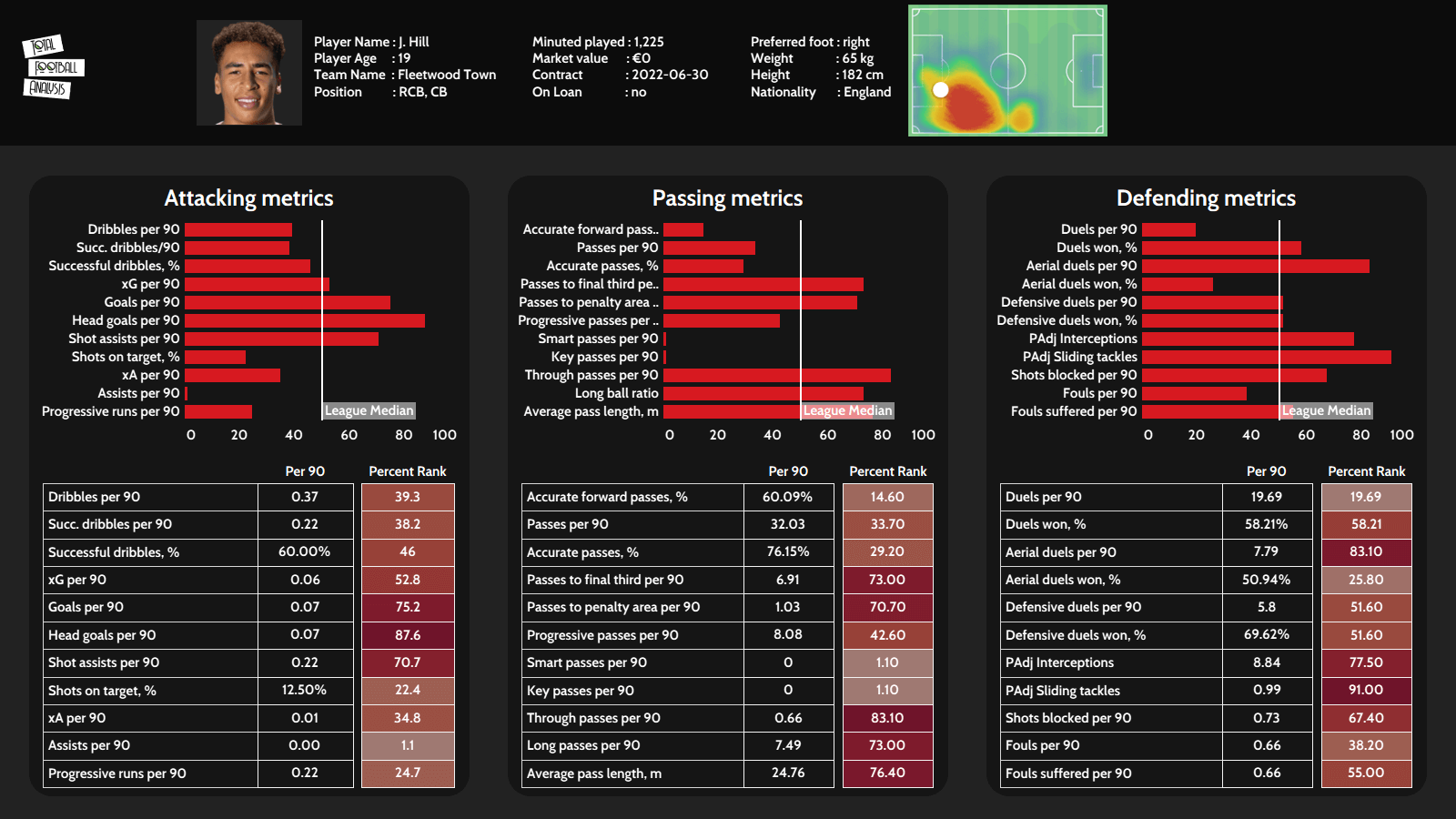
Looking at his defensive stats, Hill stands out as a very proactive defender with excellent positioning and reading of the game. He gets lots of interceptions (8.84 per 90 when possession-adjusted) and is quick to cover the back of his teammates and win the ball back with sliding tackles (0.99 per 90 with possession-adjusted). He’s not the best in duels, winning just 50.94% (well-below average) of his aerials and 69.62% of the defensive duels (average). Another positive is that he’s a clean defender, committing just 0.66 fouls per 90.
On the ball, his passing accuracy isn’t especially good (76.15%) but it’s because he attempts lots of long passes (7.49 per 90). He gets the ball into the final third and into the box very often with his long balls too. He’s also a threat from set-pieces, registering 0.06 xG and scoring 0.07 goals per 90.
In the following sections of the tactical analysis, we’ll have a deeper look at the characteristics we’ve just described.
Defensive positioning & anticipation
Hill isn’t a centre-back who stands out for his physicality. He’s not big for a centre-back and isn’t the strongest so he bases most of his defensive game on his positioning and anticipation. A very proactive defender, Hill usually tries to defend high up the pitch and avoid getting into duels by recovering the ball before it arrives at the rival he marks. His 8.84 possession-adjusted interceptions rank him better than 77% of the centre-backs in League One.
If we look at Hill’s defensive actions from the last five games below, we see there are many more interceptions (yellow triangles) than defensive duels and tackles (blue circles if successful, red if not).
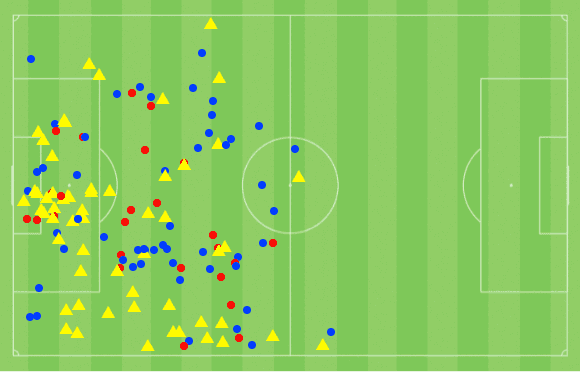
It’s also interesting to note that these interceptions occur in all areas of the pitch. In the box, his positioning to defend crosses is exceptional and he’s very eager to intercept crosses and clear the ball. Far from the box, he’s not afraid to step out of his position to anticipate and recover the ball wide or in the middle third.
To complement his intelligent positioning and aggressive anticipation, Hill possesses the pace to defend spaces and cover the back of his teammates. When he sprints towards the ball and needs to tackle, he’s tough but clean. The timing of his sliding tackles is excellent and he rarely fouls the rival despite tackling hard and winning the ball back. His possession-adjusted sliding tackles stats are excellent (0.99, top 10%) he almost doesn’t commit any fouls (just 0.66 per 90, bottom 40%).
The map below shows Hill’s defensive sprints so far this season. It shows how he runs to cover the back of the other centre-back or goes wide when his team presses high to cover the full-back position. He reads the game very well in defence and then he has the pace to get to the ball before rivals.
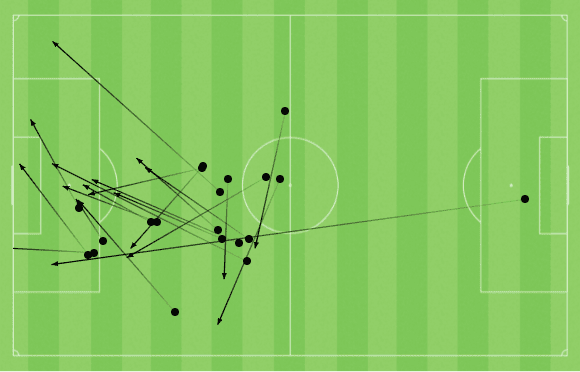
Next, we have a couple of examples of his anticipation. Always positioned at the appropriate distance and with a good angle to attack the ball, Hill displays awareness, speed in his decision making and agility to avoid his rival and cleanly get to the ball.
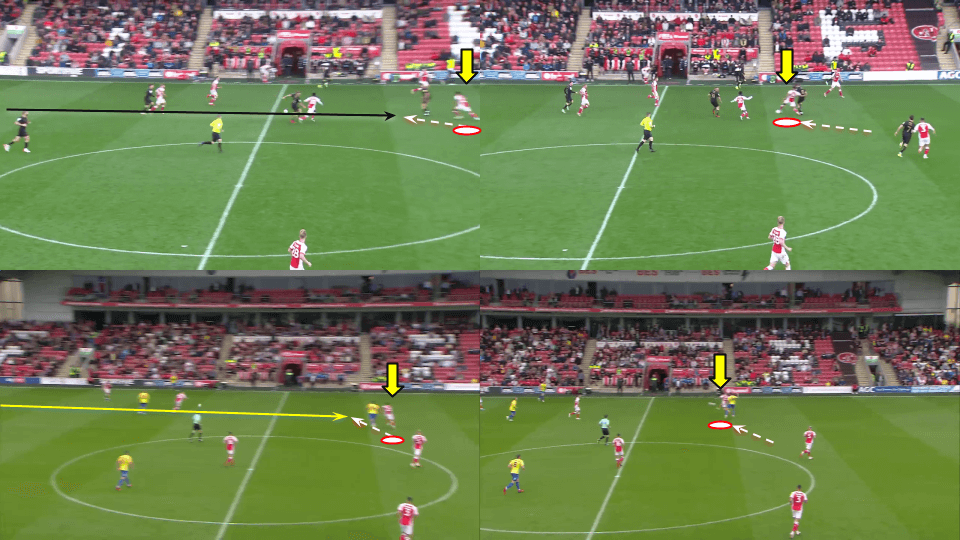
Making these decisions so quickly and accurately is a very important trait in a defender of any age but doing it aged just 19 is impressive from Hill. As we’ll see in the next section of this scout report, his decision-making and anticipation are crucial for him, as he’s not the kind of defender who can always rely on his physical superiority to win duels.
He also reads very well when he needs to cover the back of the full-back and is a step ahead of the play. The next image shows Hill covering the back of the right-back to intercept a deep pass. We see him already in full motion when the pass has just been made while the rival who was the target of the pass is still reacting. On top of that, he’s quicker than the forward and gets the ball with time and space to choose his next move.
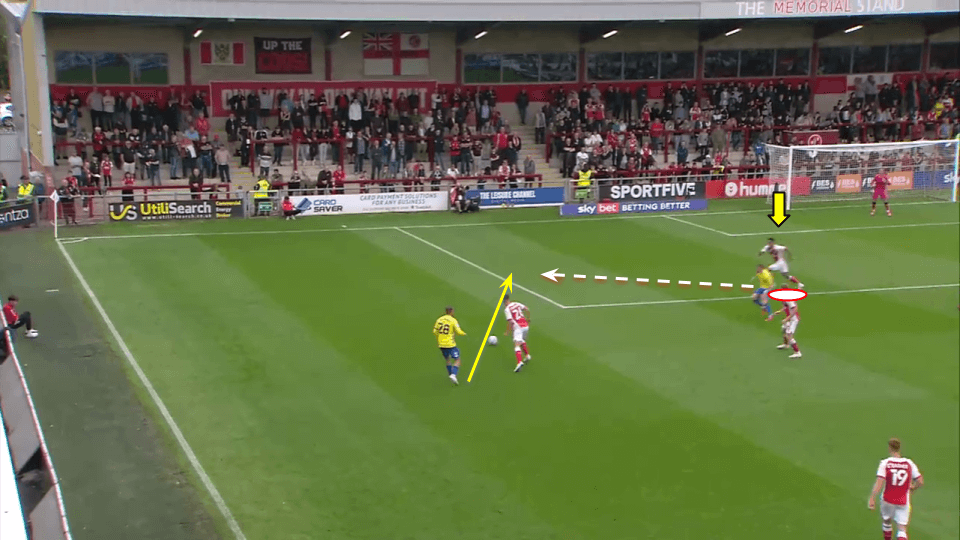
Throughout this section of the analysis, we’ve seen Hill’s main strength: his positioning and decision-making in defence. He looks very calm and mature despite his young age and looking at this, it’s easy to understand why top teams are interested in him. In the next section, we’ll see how he behaves when he’s forced into duels.
Aerial and defensive duels
Looking at Hill, you can notice he’s not a huge and physical defender. He’s quite short for a centre-back, standing at 1.82m, and isn’t particularly strong either. He does have the pace to balance that but still struggles in situations where he’s forced to challenge and compete with big, strong rivals. His jump is good and that is enough in some aerial duels but in general, he doesn’t do especially well winning just 50.94% of them, less than 75% of the centre-backs in League One.
Starting with the aerial duels, let’s have a look at the map of all the aerials Hill has been involved in this season. Hill’s success rate in aerial duels is around 50% in general but it drops a lot for headers in the box, where he has won just 42% of them. When he steps far from the box, he does much better as he has more space to anticipate and take a couple of steps before jumping so rivals can’t hold him that easily. In the rival box, he wins 64% of his headers but we’ll cover that later.
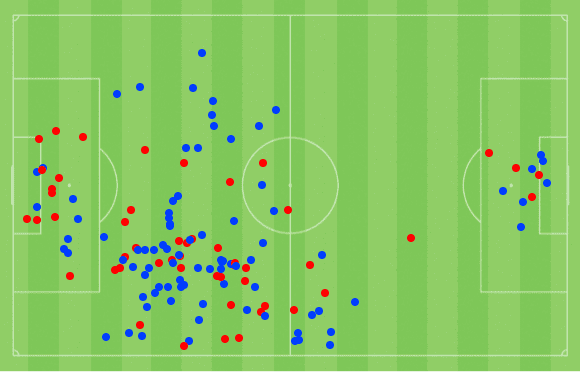
His lack of toughness in duels makes him an easy-to-target player in crosses and direct play. Rivals look to contact him so he can’t jump comfortably and once that happens, it’s easy for them to hold Hill and win headers. He contests a lot of aerial duels (7.79 per 90) as rivals often prefer to play direct passes to his area instead of to his teammate’s.
A good example of what rivals do when they engage in aerial duels with Hill is shown next. As the ball approaches, the striker clashes with Hill and tries to block him so he can’t anticipate, forcing him to contest the duel. As the ball arrives at the striker, Hill can’t even contest it in the air and loses the duel.

The next two also show times he’s failed in aerial duels. In the example on the left, he steps out to try to anticipate and win the duel but is easily pushed and overpowered by the rival. In the second one, he again tries to contest the duel but leaves space behind him, leaving a hole for the rival to take advantage of the flick on.

When looking at defensive duels, Hill does better than in the air but still has room to develop. He’s average among centre-backs in League One, winning 69.62% of his defensive duels. Again, he does better far from the box, where his speed and mobility help a lot but as he approaches the box and Zone 14. In the highlighted area, Hill won just 55% of his defensive duels.
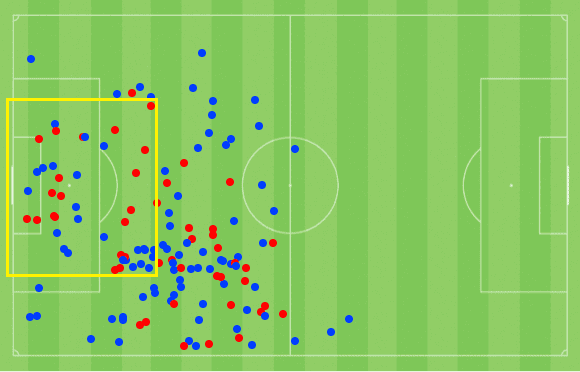
Apart from his anticipation, Hill is intelligent to recover the ball without getting into duels (he ranks much better in interceptions than in defensive duels per 90). He’s very eager to jump at any loose ball and rivals need to be very accurate with their touches as we show in the next example.
Here, we can see a sequence in which a rival controls the ball wide and Hill is behind him but doesn’t engage in the duel. As the touch isn’t perfect and Hill has a good angle, he manages to get to the ball before the rival and recover it.

In this section, we’ve seen some areas Hill needs to improve in his defensive game. He’ll never be a beast in duels so he has to keep adjusting his positioning and the way he gets into duels to be a top centre-back.
In the next part of the scout report, we’ll have a look at his contribution to Fleetwood Town’s attacks.
Build-up & attacking contribution
On the ball, Hill is calm and has good technique. He manipulates the ball very well to create passing lanes and makes good decisions, not rushing into passes and looking very composed under pressure. He’s usually the man in charge of Fleetwood Town’s build-up, getting a lot in central positions to form a back-three and launch his passes from there.
Hill stands out for his passing range. He can hit accurate passes both vertically to the same wing or diagonally to the opposite side. His stats prove his ability to play long, ranking among the best in long passes (7.49 per 90), average pass length (24.76 meters), passes to final third (6.91 per 90) and passes into the box (1.03 per 90). When playing low passes to break lines, he does ok but doesn’t stand out in progressive passes (8.08 per 90).
Looking at his long passes in the last five games, we see how Hill sprays them from the centre of the defence and the right, reaching different zones in the final third with his passing range.
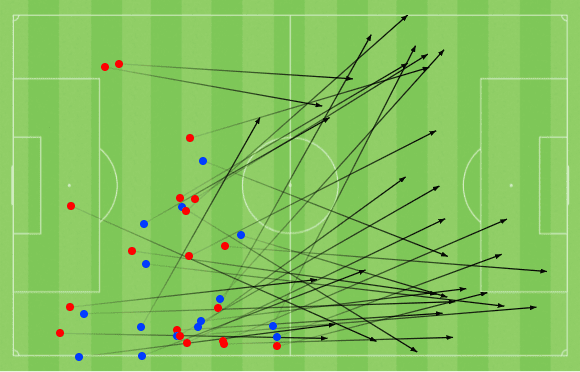
Knowing his passing range, rivals often try to press Hill. However, Hill is very calm and likes to feint and turn to leave rivals behind and open new passing options. He also knows rivals will try to press him, so he takes some extra touches to attract rivals and then passes the ball to his free teammates.

A big and quite overlooked part of Hill’s contribution in attack is his long throw-ins. He takes them for Fleetwood Town from both flanks and can reach the far post and create chances. In the map below, we see all his throw-ins that reached the box this season. He can reach the box from the middle third easily, which is a great shortcut for his team to create chances.
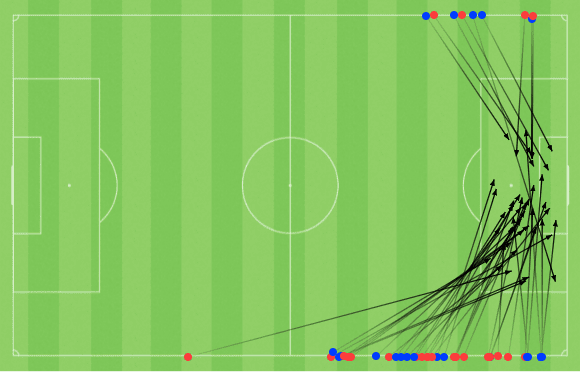
As a visual example, we have the next image. In it, we see Hill reaching the far post with his throw-in and creating a clear scoring chance.

Hill is a modern centre-back who would do even better in a team that looks to dominate possession and play from the back. Playing in a more technical environment he can become a dominant player capable of progressing the ball with long and short passes as he has the composure to make the right decisions under pressure and the technique to execute his passes accurately.
Conclusion
Hill has everything to be a great centre-back at a higher level. Despite not being especially tall or physical, he reads the game very well, is fast and very composed on the ball. His physicality will surely get better with age so he can become a complete defender.
At the moment, he could have some problems stepping into an EPL club’s starting XI, especially playing with a back-four but he could do well on the right of a back-three while he continues improving in duels.
A young, intelligent and homegrown centre-back for a price as low as £2 million as rumoured is a bargain. Choosing the right next step to continue getting valuable playing time and developing is a crucial decision for Hill and if he gets it right we can expect big things from him in the near future.





Comments